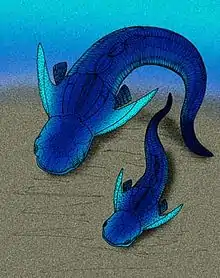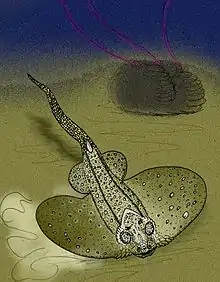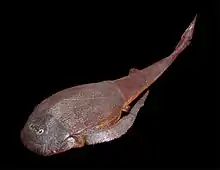Quasipetalichthys
Quasipetalichthys haikouensis is a species of extinct petalichthid placoderm from the Middle Devonian of China.
| Quasipetalichthys Temporal range: Givetian | |
|---|---|
 | |
| Scientific classification | |
| Kingdom: | |
| Phylum: | |
| Class: | McCoy, 1848 |
| Order: | |
| Family: | |
| Genus: | Quasipetalichthys |
| Species: | Q. haikouensis |
| Binomial name | |
| Quasipetalichthys haikouensis Liu, 1973 | |
Fossils
It is known primarily from two poorly preserved skulls from the Givetian-aged Haikou Formation of Haikou, Kunming, where they were found in association with remains of the antiarch placoderms Bothriolepis sinensis, and Hunanolepis.[1] The larger skull may be around 10 cm (3.9 in) in length.[2]
Phylogeny
Q. haikouensis is considered a basal petalichthyid (Denison refers to it as being "aberrant"[2]). According to Zhu's 1991 redescription of Diandongpetalichthys,[3] Quasipetalichthys, placed within Quasipetalichthyidae, is regarded as the sister group of the more advanced Macropetalichthyidae, with Diandongpetalichthys as the primitive sister group of these two taxa.[4]
Neopetalichthys is possibly closely related to Quasipetalichthys, and may or may not be placed together within Quasipetalichthyidae. Whether or not Neopetalichthys is included in the family, Eurycaraspis is placed in Quasipetalichthyidae as Quasipetalichthys' sister taxon.
References
- Long, John A. (1993). Palaeozoic vertebrate biostratigraphy and biogeography. Johns Hopkins University Press. pp. 369 (page 266). ISBN 9780801847790.
- Denison, Robert (1978). Placodermi Volume 2 of Handbook of Paleoichthyology. Stuttgart New York: Gustav Fischer Verlag. p. 40. ISBN 978-0-89574-027-4.
- Zhu, M. "New information on Diandongpetalichthys (Placodermi: Petalichthyida)." Early vertebrates and related problems of evolutionary biology. Science Press, Beijing (1991): 179-192.
- Zhu, Min & Wang, Junqing (October 1996). "A NEW MACROPETALICHTHYID FROM CHINA, WITH SPECIAL REFERENCE TO THE ZOOGEOGRAPHY OF THE MACROPETALICHTHYIDAE (PLACODERMI)" (PDF). Vertebrata PalAsiatica. 34 (4): 253–268.

